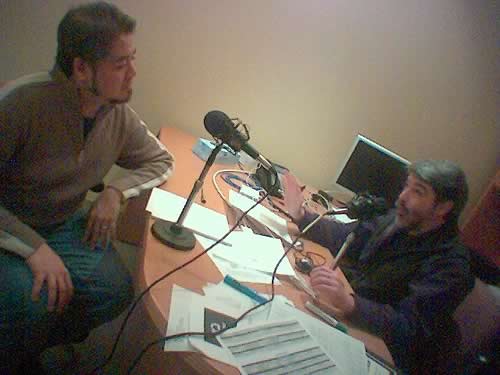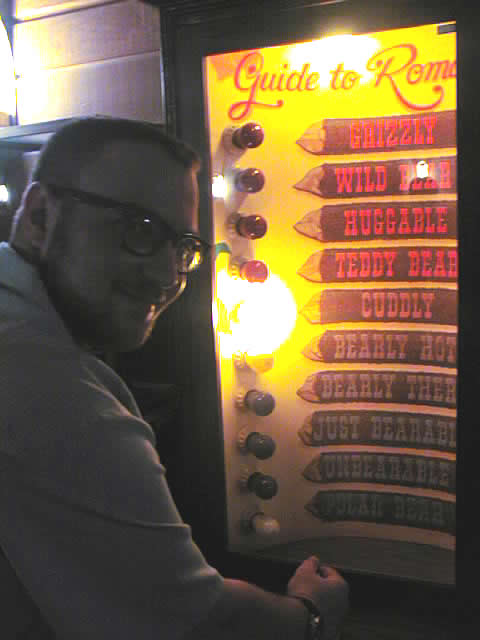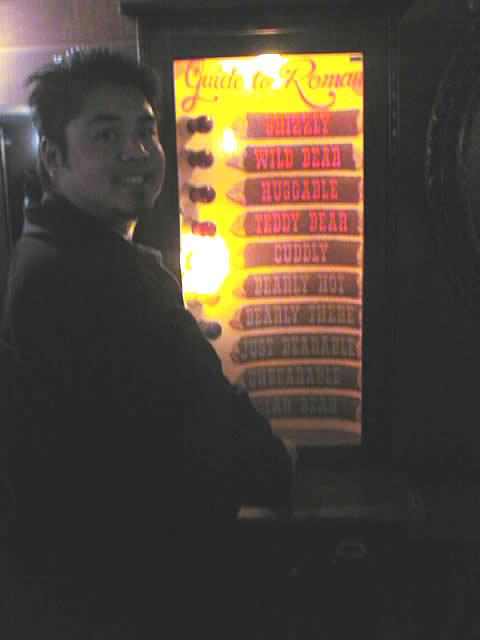This photo amuses me every time I see it. Click it to get the full-size version, suitable for desktop wallpaper.
Almost as stilted as her scenes with Hayden Christensen.
This photo amuses me every time I see it. Click it to get the full-size version, suitable for desktop wallpaper.
Almost as stilted as her scenes with Hayden Christensen.
 The podcast that I mentioned earlier — the one in which I interviews Tucows’ VP of Product Development, Alain Chesnais — now has a transcript, which I’ve posted on Tucows Developer.
The podcast that I mentioned earlier — the one in which I interviews Tucows’ VP of Product Development, Alain Chesnais — now has a transcript, which I’ve posted on Tucows Developer.
The “podcast-and-transcript” approach is the one that I’ll be taking with the podcasts over at Tucows Developer, as it offers the best of both worlds.
You might ask “Why post podcasts, anyway?”. The preliminary observations of the results of podcasts from technical websites seem to be good. At the Evans Data Developer Relations
Conference that Ross and I attended in early February, we saw that a
number of companies found that podcasts were a good way to explain the
broad strokes of a technology or product.
In his presentation, Bill Roth from BEA systems said that podcasting “lets you touch customers
at points where previously no opportunity existed.” Translated from marketer-speak, podcasting
lets you communicate with your users and customers at times you couldn’t before: on their
commute, at the gym, while running errands, and so on.
There’s also the “high-touch” factor of podcasts. It’s one thing to read
an essay or the transcript of a conversation, but another thing entirely
to hear the speakers say things in their own voice. The spoken word has a different “flow” from the written one, and a conversation between two or more people has a certain spark and spontaneity that a group-written article can’t capture.
There’s a world of great podcasts out there, and their number is growing every day. If you’d like a sample, take a look at the IT Conversations website, which features speeches and interviews with some of the brightest and most interesting minds in high tech. For a fun listen, I recommend Wil Wheaton’s “Just a Geek” presentations at the Gnomedex conference — here’s part one and here’s part two.
For the benefit of people who can’t listen to podcasts, who want to scan a podcast quickly for a specific topic or phrase and search engines, we’re also posting transcripts of our podcasts. Luckily, a service like CastingWords.com exists. CastingWords.com is the podcast transcription service whom we used to transcribe the podcast for us. They did a good job and their rates are very reasonable: they charge by podcast length — 42 cents a minute. We’ll be using their services for future podcasts.
 Here in Canada, we vote in our federal elections using a paper ballot that is standardized across the country; aside from the candidate names, the ballot looks the same no matter where you vote (for more details, see this entry). While this requires a manual counting system, it also has the added benefit of it being much harder to tamper with the results.
Here in Canada, we vote in our federal elections using a paper ballot that is standardized across the country; aside from the candidate names, the ballot looks the same no matter where you vote (for more details, see this entry). While this requires a manual counting system, it also has the added benefit of it being much harder to tamper with the results.
In the US, balloting systems vary by region: some ballots are on paper, either marked by hand or punched by voting machine, but some votes are purely electronic. The problem with the electronic systems as they are currently implemented is that they don’t leave a paper trail.
Manufacturers of electronic voting machines like Diebold insist that it’s too hard to add a paper trail system to these machines. This is a bit of a curiosity, considering that Diebold also manufactures ATMs, which are capable of provide paper receipts for each transaction and since cash registers have been able to keep a paper log of everything for decades. It’s also troubling, as voting machine manufacturers have meddled with standards organizations and Diebold’s CEO is active in partisan fundraising (he once wrote in a campaign pitch to Republicans that his company was “committed to helping Ohio deliver its electoral votes to the president”).
The blog Black Box Voting covers this issue regularly. Their most recent entry has a great graphic taken from the Washington Post — it compares Las Vegas slot machines with voting machines. Which one’s the bigger gamble?
 By the way, we here at The Adventures of Accordion Guy in the 21st Century (we reserve the right to use the “Royal we” here) would like to wish all our readers a very happy and snug-fitting Saint Patrick’s Day!
By the way, we here at The Adventures of Accordion Guy in the 21st Century (we reserve the right to use the “Royal we” here) would like to wish all our readers a very happy and snug-fitting Saint Patrick’s Day!
Ross was the sound engineer for the Tucows podcast (mentioned here), so he was able to shoot this photo with his phone:

That’s me on the left, and Alain Chesnais, VP of Product Development, on the right.
…and even managed to get some video as well [435K, MPEG-4 file].
 Don’t forget that the “Ask Tucows” Chat — in which you can chat online with me and other people who work at Tucows — takes place next Thursday at 1:00 p.m. Eastern (10:00 a.m. Pacific, 18:00 UTC). A number of people within the company have signed up to join in the conversation, so it looks as though most departments within the company will be represented.
Don’t forget that the “Ask Tucows” Chat — in which you can chat online with me and other people who work at Tucows — takes place next Thursday at 1:00 p.m. Eastern (10:00 a.m. Pacific, 18:00 UTC). A number of people within the company have signed up to join in the conversation, so it looks as though most departments within the company will be represented.
I’ll post details about the chat (including how to access the chat from your computer) next week.
Going to Disneyland is one thing; going to Disneyland with Cory Doctorow, Disneyland theme park aficionado, is something quite different. Cory’s encyclopedic knowledge of the work that goes into the design and implementation of Disneyland — imagineering, as they call it — gave me a chance to see Walt’s dream through new eyes and made it fun in a new way. I’ll post that story next week.
In the meantime, here are some grainy pictures that we took at the “Love Tester” while waiting for the Country Bear Jamboree to start. The machine gave us the same rating: “cuddly”. I thought we’d rate at least “teddy bear”.

“Are you sure this machine’s calibrated properly?”

“The ladies beg to differ!”